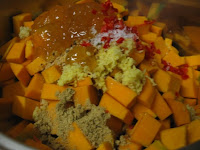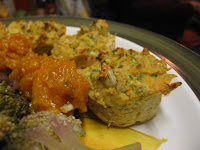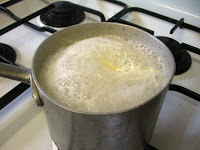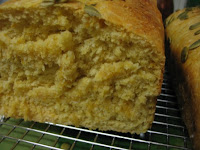 I spent last week in Darwin and was glad to get home. I didn’t eat as badly as I sometimes do when away from home but it is nothing like eating home-cooking. I had Thai stirfry on the Wharf one night, vegies and tinned soup in my room another and the hotel’s pizza on the last night. But the culinary highlight had to be the warm choc chip scones with jam and cream which we had for morning tea both days of our meeting.
I spent last week in Darwin and was glad to get home. I didn’t eat as badly as I sometimes do when away from home but it is nothing like eating home-cooking. I had Thai stirfry on the Wharf one night, vegies and tinned soup in my room another and the hotel’s pizza on the last night. But the culinary highlight had to be the warm choc chip scones with jam and cream which we had for morning tea both days of our meeting.Flying to Darwin, I did what I think is a first for me. I bought a novel at Melbourne airport and finished reading it just before the plane landed in Darwin. Not bad for about four and a half hours of flying plus sitting around in airports. (These days it is difficult to get a direct flight from Melbourne to Darwin unless you want to fly overnight.) I enjoyed escaping from the people with no idea of personal space, the chirpy air stewards, the bad food and the anticipation of a few nights staying at the airport hotel for a planning meeting. It made me realise why people buy novels at airports.
The book was one I found on the new releases shelf and had never heard of before. It is called Before I Wake and is the first novel by Canadian writer, RJ Wiersema. The novel is about a little girl in a coma whose parents make the difficult decision to turn off the life support but she continues to live while not waking from the coma. It is an engrossing story about how this affects the lives of those around her. I don’t think it is spoiling the story to reveal that it has some great scenes in a library (I was going to link to Amazon but I think their review does give away too
 much). The role of the media in the plot is interesting and I liked the touches of both magical realism and myth.
much). The role of the media in the plot is interesting and I liked the touches of both magical realism and myth.I particularly liked the description of the couple cooking together so I copied it before I passed the book to my mum to read. It makes such an everyday act seem full of beauty and meaning:
Simon was chopping vegetables on a maple block on the kitchen table when I got there, carrots falling under a large chef’s knife, a tea towel draped over one shoulder. The kitchen was bright and clean, large and well organized. Karen was at the stove with a wok. …
As Simon finished chopping the carrots and swung toward the stove, Karen stepped away, leaving a space between her body and the wok, allowing him to slide the cutting board through and to empty the carrots in, never breaking Karen’s stirring. It was a dance between two people who had been partners for years. (pp 131-2)
I also noticed that macaroni cheese is one of the comfort foods mentioned in the book. Lately E and I have discussed how his mum would make it for him as a child. It was not part of my childhood but I understand the attraction and it was on my mind when I got back to my own kitchen.
I have made some fancy versions of macaroni cheese but it is not something I make often. Many months ago I bookmarked a vegan macaroni cheese from Get Sconed. I have been curious to make a vegan version and was then further tempted by a vegan and gluten free sauce for macaroni cheese in the June 2008 edition of the Vegetarian Times. Then I got honest with myself and admitted I wanted the comfort of being at home. I needed something cheesy with a
 crispy breadcrumb topping after my body was dragged from Darwin’s tropical warmth (32 C) to Melbourne’s winter (17 C).
crispy breadcrumb topping after my body was dragged from Darwin’s tropical warmth (32 C) to Melbourne’s winter (17 C).I didn’t follow a recipe but just made a rich cheesy sauce, tossed with cooked pasta and topped it with more cheese and breadcrumbs. I baked it till it was crisp on top and oozing rich sauce inside. We agreed it was one of my best, despite not being what E's mum used to make. I have written what I did, though I know others all have their own versions of this classic and if I made it again I might make it differently. My use of dessertspoons and dessert bowls is included in the instructions to remind us that it is not a meal where exact measurements matter. (To see my photo of a dessertspoon, go here.)
But while I love the indulgent comfort of macaroni cheese, I also craved some nice vegetables after my trip away. The first night I served it I tried a salad of grated carrot and mushy apple that was a disaster so the second night I found a recipe for a cauliflower and pecan salad that caught my eye last year. But after the wonderful description of chopping carrot in the novel, I had to have carrots. I also wanted to showcase my black sesame seeds and use up vegetables in the fridge.

By the time I finished my vision of the salad the only thing it had in common with the inspiring recipe was the cauliflower. I realised it was my own recipe, probably drawing on other recipes I have read and made. Tahini is a favourite flavouring of mine and always pairs well with cauliflower. I used limes from Yaz's tree that I think are quite tart so others might not need as much sweetner as me. It was exactly the pile of healthy vegetables with an interesting dressing that I needed.
I wanted to send something to Heart of the Matter. This event is being hosted by Ilva of Lucillian Delights this month and she is asking for healthy salads, so my salad seemed perfect. And because it has been a while since I have participated, I am sending the Macaroni Cheese to Ruth at Once Upon a Feast for Presto Pasta Nights.
Macaroni Cheese
Serves 4
1 dessert bowl of dried pasta
2 dessertspoons of butter
2 dessertspoons of wholemeal flour
2 cups milk
1 tsp seeded mustard
¼ tsp smoked paprika
¼ tsp turmeric or saffron (for added colour)
50g gruyere cheese, grated
165g tasty cheese, grated
1-2 tbsp breadcrumbs
1-2 tbsp parmesan cheese, grated
Cook pasta according to instructions.
Melt butter in a medium saucepan over low heat. Mix in flour and stir over low heat for 1-2 minutes. Add milk gradually, mixing as you add it. Bring to the boil so that the roux thickens slightly. It does not need to be really thick because the cheese will help it thicken. Add mustard, paprika, turmeric, gruyere and tasty cheeses. Stir in cooked pasta.
Tip mixture into a 20cm diameter round ovenproof dish. Sprinkle with parmesan and breadcrumbs. Bake at 200 C for about 20 minutes and then turn up the heat to 230 C for about 10 minutes or til the top is crisp and starting to brown.
Cauliflower and Sesame Salad
Serves 2 hungry people or 4 normal people as a side
½ cauliflower
1 carrot, chopped into matchsticks
1 spring onion, finely sliced
1 small tomato, diced
1-2 handfuls spinach, shredded
2 tbsp parsley, finely chopped
1 mild green chilli, finely chopped
1 tsp dried garlic flakes
1 tbsp pumpkin seeds
1 tsp white sesame seeds
1 tsp black sesame seeds (or more white seeds)
Extra black sesame seeds for garnish
Dressing:
1½ tbsp lime juice
1 tbsp olive oil
1 tbsp cider vinegar
1 tbsp tahini
1-2 tsp agave nectar (or other sweeter)
1 tsp seeded mustard
Pinch salt
To make dressing: use a small whisk to blend all ingredients or use blender.
To make salad: chop cauliflower into florets and steam til just tender. I did mine in the microwave for about 3 minutes on high. Cool if desired or use warm. Add remaining ingredients and toss through with dressing. Garnish with black sesame seeds if desired.
On the Stereo:
New Gold Dream: Simple Minds

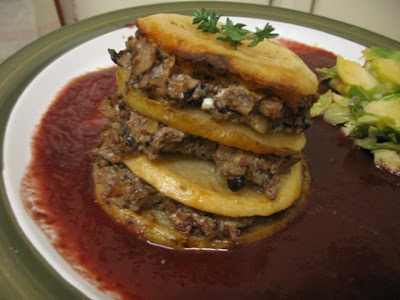



 My favourite place was Churchill Island, a small island reached by a bridge off Philip Island, which has a heritage homestead and nature walks - see above photo. (My dad visited in the late 1960s when the last resident had lived there.) The homestead owner in the 1870s was Scottish and had Highland Cattle so we were able to see some mournful hairy coos that have been returned to the island. We had great fun walking about the homestead, feeding the chickens and the horses, patting Mary the lamb, talking to George the cockatoo, laughing at the galahs and walking around the island by the spooky Moonah trees.
My favourite place was Churchill Island, a small island reached by a bridge off Philip Island, which has a heritage homestead and nature walks - see above photo. (My dad visited in the late 1960s when the last resident had lived there.) The homestead owner in the 1870s was Scottish and had Highland Cattle so we were able to see some mournful hairy coos that have been returned to the island. We had great fun walking about the homestead, feeding the chickens and the horses, patting Mary the lamb, talking to George the cockatoo, laughing at the galahs and walking around the island by the spooky Moonah trees. It will not be surprising to hear that one of my favourite meals of the trip was a pleasing plate of gnocchi at the Churchill Island Café (which is the only place to eat on the island). The café is filled with pale pine tables and chairs around a woodburning fire that gave out a very welcome warmth. In summer the seats outside would be preferable as the views down the paddocks to the sea were lovely. My pumpkin and potato gnocchi was served with a generous dollop of rich tomato sauce.
It will not be surprising to hear that one of my favourite meals of the trip was a pleasing plate of gnocchi at the Churchill Island Café (which is the only place to eat on the island). The café is filled with pale pine tables and chairs around a woodburning fire that gave out a very welcome warmth. In summer the seats outside would be preferable as the views down the paddocks to the sea were lovely. My pumpkin and potato gnocchi was served with a generous dollop of rich tomato sauce. The holiday really was about getting away from the rat race but I was surprised not to find more gourmet food. Quite possibly there are other places we missed (for example the intriguing Pink Castle on Steele Street near our B&B which had a good write-up in our Lonely Planet but was never open.) But a cafe inside a real estate agent's is not where I would expect to find the finest food - we didn't go there but did marvel at the concept. It felt like I was living on chips, pasta and pizza. So when it was done well, I was grateful.
The holiday really was about getting away from the rat race but I was surprised not to find more gourmet food. Quite possibly there are other places we missed (for example the intriguing Pink Castle on Steele Street near our B&B which had a good write-up in our Lonely Planet but was never open.) But a cafe inside a real estate agent's is not where I would expect to find the finest food - we didn't go there but did marvel at the concept. It felt like I was living on chips, pasta and pizza. So when it was done well, I was grateful. On our first day we had pikelets with jam and cream. ‘Oh just little pancakes,’ exclaimed E who is not familiar with pikelets! A couple of days later, I was pleased to be able to order a decent vegie burger, chips and a potato cake in a traditional fish and chip shop style. Again E doesn’t understand this type of place but it is where Catholic families like mine would head to on a Friday for some fish and chips wrapped in paper to take home to their families. His UK equivalent would be the chippie. I had enough of this sort of food as a child for it to be comforting, if not healthy, and to get excited where there is anything more than deep fried potatoes on offer for vegetarians.
On our first day we had pikelets with jam and cream. ‘Oh just little pancakes,’ exclaimed E who is not familiar with pikelets! A couple of days later, I was pleased to be able to order a decent vegie burger, chips and a potato cake in a traditional fish and chip shop style. Again E doesn’t understand this type of place but it is where Catholic families like mine would head to on a Friday for some fish and chips wrapped in paper to take home to their families. His UK equivalent would be the chippie. I had enough of this sort of food as a child for it to be comforting, if not healthy, and to get excited where there is anything more than deep fried potatoes on offer for vegetarians. On our final night we went to Isola de Capri (cnr Thompson Avenue and the Esplanade, Cowes). By then I just needed some vegetables so I ordered pumpkin soup and steamed vegetables. It was delicious and so filling that I couldn’t fit in dessert. E had pizza which he said was excellent and seemed much better than pizza we had elsewhere. The staff were friendly, the restaurant bustling and it felt like it was run by an Italian family rather than teenagers on holiday. The grand prix memorabilia reminded us that this is one of the other attractions for visitors. I was glad of my warming meal after sitting in the cold waiting to see the famous penguins.
On our final night we went to Isola de Capri (cnr Thompson Avenue and the Esplanade, Cowes). By then I just needed some vegetables so I ordered pumpkin soup and steamed vegetables. It was delicious and so filling that I couldn’t fit in dessert. E had pizza which he said was excellent and seemed much better than pizza we had elsewhere. The staff were friendly, the restaurant bustling and it felt like it was run by an Italian family rather than teenagers on holiday. The grand prix memorabilia reminded us that this is one of the other attractions for visitors. I was glad of my warming meal after sitting in the cold waiting to see the famous penguins. As well greats places to get close to wildlife, we did find some lovely gift shops, a trash and treasure of hidden gems, and an excellent health food store in Cowes. After finding it near impossible to find unsweetened dried cherries in Melbourne, I was surprised to discover a packet from a local source. A bridge from St Remo on the mainland makes Philip Island easily accessible. In the shadow of the bridge was a small shopping strip with more gift shops of beauty and curiosity.
As well greats places to get close to wildlife, we did find some lovely gift shops, a trash and treasure of hidden gems, and an excellent health food store in Cowes. After finding it near impossible to find unsweetened dried cherries in Melbourne, I was surprised to discover a packet from a local source. A bridge from St Remo on the mainland makes Philip Island easily accessible. In the shadow of the bridge was a small shopping strip with more gift shops of beauty and curiosity. Then we headed homeward, stopping at Wicked Sensations (shop 6, number 1, High Street) in Cranbourne for a bite sized mini choc chip muffin drizzled in raspberry sauce for me and a small berry chocolate for E. After that we hit the freeway and drove til we arrived at the Cat Motel where Zinc was eagerly waiting to come home with us.
Then we headed homeward, stopping at Wicked Sensations (shop 6, number 1, High Street) in Cranbourne for a bite sized mini choc chip muffin drizzled in raspberry sauce for me and a small berry chocolate for E. After that we hit the freeway and drove til we arrived at the Cat Motel where Zinc was eagerly waiting to come home with us. 
